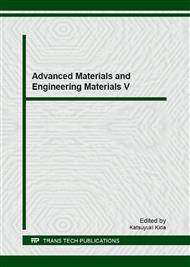[1]
S. T. Oh, W. R. Kim, S. H. Kim, Y. C. Chuang, J. S. Park, The preparation of polyurethane foam combined with ph-sensitive alginate/bentonite hydrogel for wound dressings, Fibers Polym. 12 (2011) 159-165.
DOI: 10.1007/s12221-011-0159-4
Google Scholar
[2]
S. Fu, A. Thacker, D. M. Sperger, R. L. Boni, I. S. Buckner, S. Velankar, E. J. Munson, L. H. Block, Relevance of rheological properties of sodium alginate in solution to calcium alginate gel properties, AAPS Pharm. Sci. Tech. 12 (2011) 453-460.
DOI: 10.1208/s12249-011-9587-0
Google Scholar
[3]
P. K. Gupta, A. K. Jaiswal, S. Asthana, A. Verma, V. Kumar, P. Shukla, P. Dwivedi, A. Dube, P. R. Mishra, Self assembled ionically sodium alginate cross-linked amphotericin b encapsulated glycol chitosan stearate nanoparticles: applicability in better chemotherapy and non-toxic delivery in visceral leishmaniasis, Pharm. Res. 32 (2015).
DOI: 10.1007/s11095-014-1571-4
Google Scholar
[4]
T. Chae, H. Yang, V. Leung, F. Ko, T. Troczynski, Novel biomimetic hydroxyapatite/alginate nanocomposite fibrous scaffolds for bone tissue regeneration, J. Mater. Sci. Mater. Med. 24 (2013) 1885-1894.
DOI: 10.1007/s10856-013-4957-7
Google Scholar
[5]
B. Kusuktham, J. Prasertgul, P. Srinun, Morphology and property of calcium silicate encapsulated with alginate beads, Silicon. 6 (2014) 191-197.
DOI: 10.1007/s12633-013-9173-z
Google Scholar
[6]
H. Lin, C. Yeh, Alginate-crosslinked chitosan scaffolds as pentoxifylline delivery carriers, J. Mater. Sci. Mater. Med. 21 (2010) 1611-1620.
DOI: 10.1007/s10856-010-4028-2
Google Scholar
[7]
M. H. Kafshgari, M. Mansouri, M. Khorram, S. R. Kashani, Kinetic modeling: a predictive tool for the adsorption of zinc ions onto calcium alginate beads, Int. J. Ind. Chem. 4 (2013) 5-12.
DOI: 10.1186/2228-5547-4-5
Google Scholar
[8]
D. Wang, F. Zhang, J. Tang, Sodium alginate decorated carbon nanotubes-graphene composite aerogel for heavy metal ions detection, Electrochem. 83 (2015) 84-90.
DOI: 10.5796/electrochemistry.83.84
Google Scholar
[9]
S. Y. Weng, S. H. Liu, L. C. Tsai, T. F Hsieh, C. M. Ma, C. M. Shu, Thermokinetics simulation for multi-walled carbon nanotubes with sodium alginate by advanced kinetics and technology solutions, J. Therm. Anal. Calorim. 113 (2013) 1603-1610.
DOI: 10.1007/s10973-013-3092-5
Google Scholar
[10]
S. F. Mohamed, F. Agili, M. M. Asker, K. E. Shebawy, Characterization of the biosorption of lead with calcium alginate xerogels and immobilized turbinaria decurrens, Monatsh. Chem. 142 (2011) 225-232.
DOI: 10.1007/s00706-011-0452-3
Google Scholar
[11]
L. Fuks, A. Oszczak, E. Gniazdowska, D. Sternik, Calcium alginate and chitosan as potential sorbents for strontium radionuclide, J. Radioanal. Nucl. Chem. 304 (2015) 15-20.
DOI: 10.1007/s10967-014-3698-5
Google Scholar
[12]
D. Lu, Y. Zhang, S. Niu, L. Wang, S. Lin, C. Wang, W. Ye, C. Yan, Study of phenol biodegradation using Bacillus amyloliquefaciens strain WJDB-1 immobilized in alginate-chitosan-alginate (ACA) microcapsules by electrochemical method, Biodegradation. 23 (2012).
DOI: 10.1007/s10532-011-9500-2
Google Scholar
[13]
L. Jin, Z. L. Ding, D. J. Chen. Zinc octacarboxylic phthalocyanine/lutein dyads co-adsorbed nanocrystalline TiO2 electrode: enhancement in photovoltaic performance of dye-sensitized solar cells, J. Mater. Sci. 48 (2013) 4883-4891.
DOI: 10.1007/s10853-013-7268-y
Google Scholar
[14]
W. Lu, W. Chen, L. Nan, M. H. Xu, Y. Y. Yao, Oxidative removal of 4-nitrophenol using activated carbon fiber and hydrogen peroxide to enhance reactivity of metallophthalocyanine, Appl. Catal. B-Environ. 87 (2009) 146-151.
DOI: 10.1016/j.apcatb.2008.08.024
Google Scholar
[15]
R. Chen, Z. Chen, X. Zheng, X. Chen, S. Wu, Preparation and Characterization of mSA/mCS Bipolar Membrances Modified by CuTsPc and CuTAPc, J. Membrane. Sci. 355 (2010) 1-6.
DOI: 10.1016/j.memsci.2010.01.013
Google Scholar
[16]
R. Chen, Z. Huang, X. Zheng, C. Zhen, Paired Electro-generation of Glyoxylic Acid Using Bipolar Membrane Made from Sodium Alginate and Chitosan, Chem. Eng. Commun. 197 (2010) 1476-1484.
DOI: 10.1080/00986445.2010.484993
Google Scholar
[17]
M. Xu, H. Chen, G. Pan, P. Tang. Preparation of zinc phthalocyanine-calcium alginate gel beads and its use for photocatalytic oxidation decolorization of methyl orange, Mater. Sci. Forum. 809-810 (2015) 252-257.
DOI: 10.4028/www.scientific.net/msf.809-810.252
Google Scholar
[18]
S. Seelan, M. S. Agashe, D. Srinivas, S. Sivasanker, Effect of peripheral substitution on spectral and catalytic properties of copper phthalocyanine complexes, J. Mol. Catal. A-Chem. 168 (2001) 61-68.
DOI: 10.1016/s1381-1169(00)00534-3
Google Scholar


